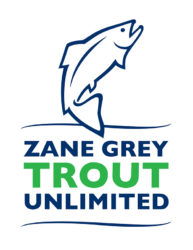Homeward bound out of Phoenix, I couldn’t believe how much water was on the landscape. More exactly, how much water was in the landscape, for as we all know, water in its physical, palpable form is a rare sight among the rocks and draws of the Sonoran hardscrabble. The water I saw was in the form of plants, saguaros, mesquite and yellow flowers. Hillsides of prickly pear in bright light green. Happy green, the kind that tells you that a plant has downed some drinks.
Though not drunk myself, I was definitely hung over from the surplus of inspiration I’d consumed at the Arizona Native and Wild Trout Conference, an annual event in Phoenix that my wife refers to as “Geek Fest.” Yes, I do love this conference. It enables me to see Arizona at it’s green and cool best. I enjoy catching up with the friends I’ve made at the conference over the years, fellow geeks from Arizona TU’s over-achieving council and chapters. The final evening’s barbeque feed is always a special treat.
My favorite part, of course, is the conference itself. We heard about the exhaustive lengths to which an Arizona Game and Fish hatchery professional went in growing recreational Gila trout from eggs, his emotional ups and downs as he faced egg and fish mortality with limited resources and a dedicated staff. I remember wondering if I, when of such a young age, would have been so stalwart against such looming odds, or if my penchant to throw the towel would have kicked in.
From Jim Brooks, the preeminent Southwest native fish biologist, we learned about the enormous power of citizen science and the potential value of using rapid habitat assessments to prioritize restoration projects. Brooks reminded us that citizen science is cheap, can yield data of the highest quality, and most important, is absolutely necessary in our race against the ruthless clock of climate change.
We were also treated to Chris Wood’s riveting and urgent key note address on why restoring Southwest native trout matters. The question had been bugging me for some time and thanks to Chris, was still with me as I climbed out of the desert and into the pinon and juniper outskirts of Payson.
I was listening to sports radio. The show hosts were holding a contest in which the winning caller would qualify for a trip to this year’s NFL draft. I thought, “Now why would someone want to do that?”
“Simple,” I answered myself, “because it matters.”
Maybe not in the life and liberty sense, but definitely in the pursuit of happiness, and given that approximately 100 percent of the human population engages in some form of this pursuit now and then, it’s reasonable to assume that what matters, be it of emotional or rational origin, may be real. Think about it. As a noun, the word “matter” is defined as “a physical substance.” As a verb, it means “to be of significance.”
I continued through Payson towards Tonto Creek (one does not drive through unfamiliar territory without at least attempting to fish it), suspicious that I was onto something.
I parked at the hatchery and walked downstream. It felt good to stretch my legs after two long days of sitting, to be outdoors and to smell things. The water was a frigid 45 degrees, no surprise that I only caught two stockers. Filling the spaces between firs, sycamores and towering beech trees were Manzanita shrubs and Gambel’s oak, and it occurred to me that I’d never seen all of these species together in one place. I also noticed, again, the beautiful violence common to Mogollon Rim watersheds, the felled Ponderosa logs across piles of pushed rubble, the historical rotation of wildfire and flood. Caught in a sudden squall of corn snow, I wet-waded my butt out of there and hit the road for home.
The blizzard lasted for another hour as I drove slowly along the Rim while searching my mind for the meaning of Arizona. The Mogollon Rim, a 200 mile long escarpment at the southwestern edge of the Colorado Plateau, is home to the world’s most expansive Ponderosa ecosystem. South and east of the Mogollon, the White Mountains rise. Arizona’s land features have made its streams, which in turn have shaped the land.
And for all they have made together, Arizona’s land and streams did not make brook trout or rainbows, and they most definitely did not make browns. Not to say these fish don’t have their place. Like humans who’ve migrated from elsewhere, they most certainly do. True as that may be, it is also true that Arizona is most elementally defined by its rocks and weird plants, its horned lizards, rattlesnakes, and tarantulas. By its Apache trout and Gilas. In their own original way, these are the things that matter in this place.
It is the place that made them, the Arizona, we must acknowledge, that they have made.
Toner Mitchell is New Mexico the water and habitat coordinator for Trout Unlimited. He lives and works in Santa Fe.
